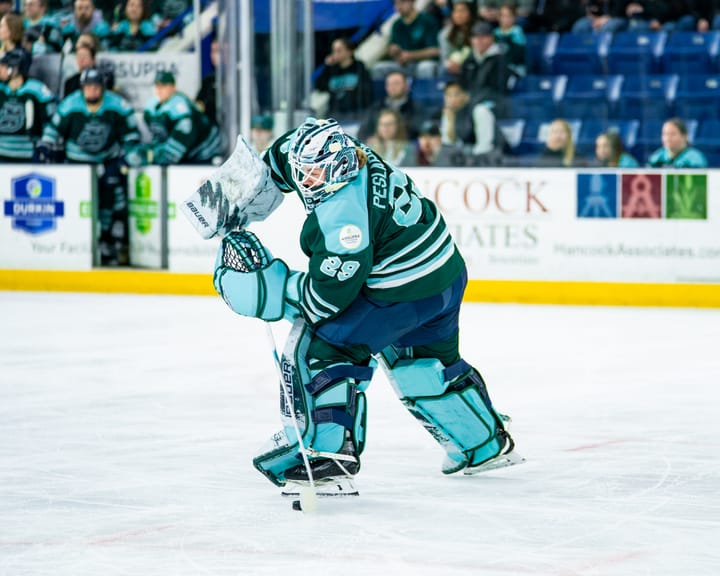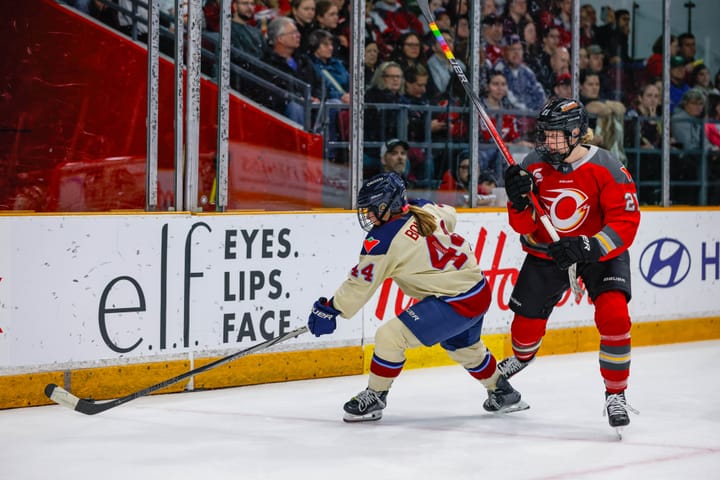Denmark on the rise: Q&A with national team coach Fredrik Glader
As the Danish Lions prepare for the Division I Group A World Cup in Hungary next week, they’re also working on a bigger mission: to make it to the Olympics.
The small nation of Denmark might not be as well known for its hockey as its neighbors elsewhere in Scandinavia, but the its women’s national team has big plans for expansion in the future. The Danish lions are currently preparing to head to Hungary for the IIHF World Championship Division I, Group A tournament in Budapest, Hungary, which runs April 7 - 13.
Although the team has never qualified for an appearance at the Olympics and their last time competing in the IIHF Top Division was in 1992, head coach Fredrik Glader has high hopes for Denmark’s future in international play. Glader, who has coached the SDHL’s Luleå Hockey during their back-to-back league championships, joined the national team’s staff this fall. This will be his first world tournament with Denmark.
The Ice Garden met with Glader at the team’s practice rink in Kastrup, Denmark to discuss the upcoming tournament and the team’s future.
The Ice Garden: What’s the hockey culture like in Denmark?
Fredrik Glader: I think the hockey culture is small here. I have been working here since autumn, so I haven’t dug into everything about this culture, but I know it’s very small. There are a few hundred players registered in Denmark, and you can compare that to Canada which has over 80,000, or Sweden, which has 5,000. But you have a lot of good players here on the national team— ones who are playing college hockey in the U.S. and ones playing in Sweden in the SDHL. It needs a lot of hard work to grow the culture, both for men and women.
TIG: What kind of work is being done in Denmark right now to grow the game for younger girls?
Glader: I think that’s on the clubs, but I know that they have a lot of girls that are playing. The same work that we’re doing in Sweden needs to be done. We need to have women that are stars in the Denmark who show up to the clubs and help the young girls. The national association has made the decision that they’re going to push more for women’s hockey, so I think the big work will start from now and go forward. We’re at the beginning of something that possibly can grow.
TIG: What are your goals for this team in the next few years?
Glader: For long term, it’s the Olympics. That’s a couple years away, but we’ve started this now. We have started this in the autumn when I came in— we’re going to get into a practice culture where we work hard off ice and on ice, but you also need to plan your practicing around study and working. We start working for it now.
We have Worlds ahead of us, and we have a goal that we want to win that, and that means that we can go up to the Top Division. We need to take it step-by-step. Our goal is winning the tournament now.
TIG: What are the main things you’re doing to make that happen?
Glader: We help them off ice with how they’re going to practice, especially with running, the gym, and eating and sleeping good. We help them plan their days to follow a schedule to be in better shape and be stronger. Here in Denmark we have a lot of technical skills players, but we make the physical status better so we can grow as a team. That’s why we’re helping them so we can get the whole package of a professional player.
TIG: In this upcoming tournament in particular, what things are you going to be focusing on?
Glader: Skating. Skating, skating, and skating. That’s the same thing between Luleå and Denmark is that we want to play with a lot of skating. If we can keep the tempo in the game and have that, then it’s going to be tough to beat us. It’s the one thing that makes me frustrated and make me raise my voice. Mistakes happen on the ice, of course, I understand that, but if you don’t skate then I am frustrated.
TIG: What are this roster’s strengths?
Glader: The strength is that this is a team, and we work hard for each other and have fun together. You can’t be better as a team if you don’t have fun, because everyone wants to play hockey, but we need to work hard to have fun also. We’re working together to find a system that’s going to make us really hard to beat in games. We want to play with speed and big pressure, and everyone is starting to know it. We’re not there yet, but we’re going to be there at the Olympics.
TIG: On the flip side of that, what are the team’s biggest weaknesses?
Glader: I think it’s that we have just started something new and there’s many things we need to practice right. It’s a weakness that not everyone is there yet with physical status and with tactical things. We are on a different level from the first player to the last player, and that’s a weakness.
TIG: You have a few more cuts to make before you head to Hungary. What will you be looking for when you finalize that roster?
Glader: We have talked a lot about competition. Of course many of us are friends with each other during the year, but when we are on the ice they are opponents. We need to be competitive all the time on the ice. If I’m going to war, I want to have fighters with me. I also want to make sure that my players get what I’m saying and helping to push each other, but the most important thing is that I want to see a lot of competition.
TIG: Have you had any challenges with your players who are playing in college in the States?
Glader: When their coaches are saying they can’t come to the national team when we come together, that affects us. If they haven’t been here for the last two tournaments we’ve played and they come here and start competing now, it’s time for me to know them and it’s not good. We need to find a way with the college team to release them for at least one tournament before we come to Worlds now.
TIG: Which players stand out the most to you right now?
Glader: We have a lot of players that stand out! We have really good players like Josefine Jakobsen, Nicoline Jensen, and Josefine Persson. We also have a couple good defenders who go out and work hard, but if I had to pick three players, it would be them. But we have a lot of good players behind them at a really good level.
TIG: Who is your biggest rival coming up in this tournament?
Glader: I would say it’s Hungary. They’ve done a lot of good work for a couple years now and pushed their national team hard. They also have the Worlds at home, but I can see them being a rival. Overall I can see it being so tied between all these teams, so we need to not look too forward, because we need to focus on one game at a time.
TIG: What are the challenges of coaching both this team and Luleå in the SDHL?
Glader: Of course it’s the time. I am as a person the one who, if I take a team, I want to win and do whatever it takes. I have good staff members on both the club team and the national team and we help each other, and that makes it better for both teams. We won the league, the gold, now in the SDHL, so that shows that I do my work in the club team. When I am with the club team I am there totally, and when I am with the national team I am there totally. But it’s definitely the time, because of course I have a family and three kids also.
TIG: Are there any big differences between coaching in Sweden and here in Denmark?
Glader: Yes, it is different. You need to coach the group you have based on which level they are. I can’t do the same in Luleå as I can in Denmark, so it’s different small things, but also how I give my feedback. The language is a little bit different so you need to make sure that everyone has got what you say.
TIG: Is it challenging at all to coach players here who you play against in the SDHL?
Glader: Of course we are joking a bit with each other! But I am greatly humbled because I know what it’s like to be on the other side against them, and I can take that with us here. But we have fun with it.
TIG: You’ve been talking a lot about having fun. How do you encourage the team to have fun?
Glader: It’s important that we as coaches can have a smile on our face. The door is always open, so players can talk to us if there’s something we need to know, both if it’s something with hockey or their social life. They know that they can feel that they are safe with us and I am always behind them. I am not going to throw anyone under the bus and they know I am there to help. When something is happening outside the rink or on the ice we can laugh with each other. That’s the important thing— we are human people; we are not machines or something. We have feelings and sensitivities and everything like that, so we can have all of that together.





Comments ()